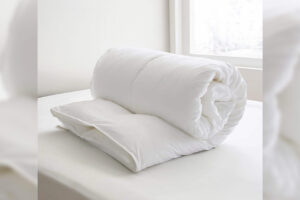Clothes alteration services are temporarily unavailable at all locations.
Can Dry Cleaning Shrink Clothes? [A Reality Check]
- By White's Laundry
- 01 August 2025
If you’ve ever picked up your favorite dress or tailored blazer from the dry cleaner only to find it fitting a bit snugger than before, you’re not alone. The question is — did the dry cleaning process shrink your clothes?
This is a common concern, especially for those who regularly entrust their delicate or expensive garments to professional cleaners. In this article, we’ll break down what really happens during dry cleaning, whether shrinkage is possible, and how you can avoid it.
What Is Dry Cleaning, Really?
Despite the name, dry cleaning isn’t actually “dry.” It’s a cleaning process that uses solvents instead of water to remove dirt, stains, and oils from fabrics. The most commonly used solvent is perchloroethylene (or “perc”), although some cleaners use eco-friendly alternatives.
Garments are placed in a machine that looks similar to a washing machine, but instead of using water and detergent, it circulates solvent through the fabric to dissolve grime. The process is followed by controlled drying and pressing.
Since no water is involved, dry cleaning is typically much gentler on fabrics that don’t respond well to traditional laundering — like silk, wool, and rayon.
Does Dry Cleaning Shrink Clothes? The Short Answer
In most cases, no — dry cleaning does not shrink clothes. The process is specifically designed to clean garments while maintaining their size, shape, and texture.
However, there are some exceptions. While rare, shrinkage can occur under certain conditions, often due to human error, fabric sensitivity, or improper handling.
When and Why Shrinking Can Happen
Here are some scenarios where garments might shrink during or after dry cleaning:
Steam Finishing Errors
While the cleaning itself is solvent-based, garments are often steamed or pressed afterward. Excessive heat or pressure during this finishing step can cause some fabrics to tighten or shrink.
Residual Moisture
Even though water isn’t used in the cleaning cycle, pre-spotting treatments or steaming can introduce moisture. Some fabrics, especially natural fibers, may react unpredictably to heat and moisture combinations.
Inexperienced Handling
Improper temperature settings or failure to recognize a fabric’s sensitivity can lead to unwanted shrinkage. This is more likely with poorly trained staff or budget dry cleaning operations.
Fabric Characteristics
Some materials, like wool or rayon, are more prone to shrinkage due to their natural fibers and weave. These fabrics may relax or tighten depending on how they’re cleaned and dried.
Fabrics More Likely to Shrink
Not all fabrics react the same way. Here’s a breakdown of how different materials typically respond:

Wool, in particular, can “felt” or shrink when exposed to heat and agitation — which is why special care is taken during dry cleaning.
How Dry Cleaners Prevent Shrinking
Professional dry cleaners take several precautions to ensure that garments retain their original size and shape throughout the cleaning process. Here’s how they do it:
- Thorough Fabric Inspection: Before cleaning begins, garments are carefully inspected for fabric type, construction, embellishments, and care label instructions. This helps the cleaner determine the safest cleaning method. Any pre-existing conditions like loose seams, weak fibers, or previous shrinkage issues are noted to avoid further damage.
- Solvent and Temperature Control: The cleaning solvent’s temperature and composition are closely monitored. Sensitive fabrics require specific solvent concentrations and lower temperatures to prevent fiber contraction or distortion. Good dry cleaners use calibrated machines that are regularly maintained to ensure consistency.
- Gentle Drying and Steam Pressing: After cleaning, garments are dried using temperature-controlled systems. Overheating is avoided, especially for delicate or natural fabrics. During finishing, steam is applied carefully — too much steam or pressure can cause garments to shrink or lose shape. Skilled pressers tailor their techniques based on the fabric’s behavior.
- Reshaping and Blocking: As garments dry, they are reshaped manually or with specialized tools to ensure they maintain their intended structure. This is particularly important for structured clothing like suits, blazers, or knitwear, where even minor shrinkage can affect fit and appearance. Blocking boards, pads, and mannequin forms may be used during this stage.
What You Can Do to Avoid Shrinking
While professional dry cleaners follow best practices to minimize the risk of shrinkage, there are several proactive steps you can take as a customer to ensure your clothes are cared for properly:
- Read and Understand the Care Label: Always take a moment to read the label inside your garments. If it says “dry clean only,” that’s usually for a good reason — the fabric may be sensitive to water, agitation, or heat. Even if it says “dry clean recommended,” it’s best to follow that guidance, especially for structured or delicate items like suits, dresses, or embellished clothing.
- Communicate Clearly with Your Cleaner: Don’t hesitate to point out any concerns when dropping off your clothes. If a garment has sentimental value, is made from a delicate fabric, or has previously shrunk or stretched, let the staff know in advance. The more information they have, the better they can tailor the cleaning process.
- Choose an Experienced, Reputable Dry Cleaner: Not all dry cleaners are created equal. Look for one with good reviews, transparent cleaning practices, and experience handling a variety of fabrics. A skilled cleaner will know how to treat different materials appropriately — and will take extra care with risk-prone items.
- Be Cautious with Home Spot Cleaning: It’s tempting to treat a spill at home with a damp cloth or stain remover, but be careful. Water or cleaning agents can alter how the fabric reacts during dry cleaning, especially if it’s left wet or improperly rinsed. Whenever possible, leave stain treatment to the professionals or at least consult them before applying anything yourself.
What to Do If a Garment Shrinks
If you notice shrinkage:
- Contact the Cleaner Immediately: Many offer inspections and will take responsibility if the damage occurred due to their process.
- Ask About Restoration: Some fabrics can be carefully stretched back into shape or adjusted through professional pressing.
- Know When to Replace: In rare cases, irreversible shrinkage may mean the garment can’t be saved — especially with fitted items like blazers or gowns.
The Bottom Line
Dry cleaning is generally a safe process that doesn’t shrink clothes. When shrinkage does occur, it’s usually due to specific fabric sensitivities or mishandling — not the cleaning itself.
To stay on the safe side, choose a dry cleaner who understands fabric care, and don’t hesitate to ask how your garments will be treated. After all, proper garment care is about more than just looking clean — it’s about keeping clothes looking new, year after year.





